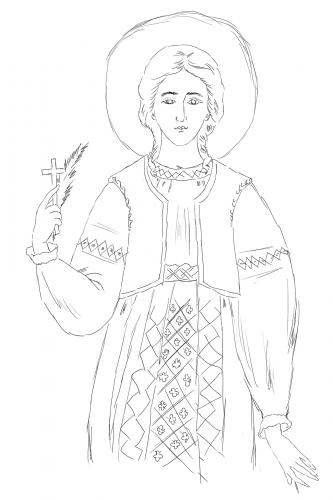



Saint Philothea of Arges
St. Philothea or Filofteia lived at the beginning of the 13th. Century in Tarnovo (today Veliko Tarnovo) in Bulgaria, but her relics were brought to Curtea de Arges, in Wallachia, during the reign of Mircea cel Batran (the Elder), 1385-1418.
According to the contemporary version of the hagiographic legend, Philotheia came from a peasant family and it is said that her mother had been Romanian. She was raised a Christian, her name meaning "lover of God". As in many hagiographies of martyred children or teenagers, the step mother played a fateful part by estranging the father from the future martyr, while persecuting her. When 12 years' old Philotheia offered as almsgiving the food and clothes she had to bring to her father who was toiling the fields, the latter, enraged, hurt her with an axe. The festered wound caused her death. The legend goes on that nobody could raise Philotheia's body from the field until the Curtea de Arges monastery was mentioned as her place of burial.
Iconographically, there is no special representation for St. Philotheia, depicted, according to the Byzantine and Post-Byzantine canon, as one of the virgin martyrs. But the icon and fresco painters of the Romanian school used a special canon in this case. The saint is represented as a young adolescent, is depicted either full-length or half-length, bear-headed, her hair pleated in a tress and dressed in a long sleeved peasant blouse, an embroidered or fur-trimmed vest and a long skirt or apron decorated with vertical stripes, garments suggesting the Bulgarian popular costume. In her hand she is holding a cross or a palm branch, the latter being the attribute of martyrs. Later on the decoration of the skirt or apron has changed according to the Romanian popular style. The axe, as the instrument of the martyrdom, appears more frequently. In modern representations, however incorrectly, the saint's head is covered by a veil, indicating thus a married woman and not a very young virgin.
St. Philothea or Filofteia lived at the beginning of the 13th. Century in Tarnovo (today Veliko Tarnovo) in Bulgaria, but her relics were brought to Curtea de Arges, in Wallachia, during the reign of Mircea cel Batran (the Elder), 1385-1418.
According to the contemporary version of the hagiographic legend, Philotheia came from a peasant family and it is said that her mother had been Romanian. She was raised a Christian, her name meaning "lover of God". As in many hagiographies of martyred children or teenagers, the step mother played a fateful part by estranging the father from the future martyr, while persecuting her. When 12 years' old Philotheia offered as almsgiving the food and clothes she had to bring to her father who was toiling the fields, the latter, enraged, hurt her with an axe. The festered wound caused her death. The legend goes on that nobody could raise Philotheia's body from the field until the Curtea de Arges monastery was mentioned as her place of burial.
Iconographically, there is no special representation for St. Philotheia, depicted, according to the Byzantine and Post-Byzantine canon, as one of the virgin martyrs. But the icon and fresco painters of the Romanian school used a special canon in this case. The saint is represented as a young adolescent, is depicted either full-length or half-length, bear-headed, her hair pleated in a tress and dressed in a long sleeved peasant blouse, an embroidered or fur-trimmed vest and a long skirt or apron decorated with vertical stripes, garments suggesting the Bulgarian popular costume. In her hand she is holding a cross or a palm branch, the latter being the attribute of martyrs. Later on the decoration of the skirt or apron has changed according to the Romanian popular style. The axe, as the instrument of the martyrdom, appears more frequently. In modern representations, however incorrectly, the saint's head is covered by a veil, indicating thus a married woman and not a very young virgin.




